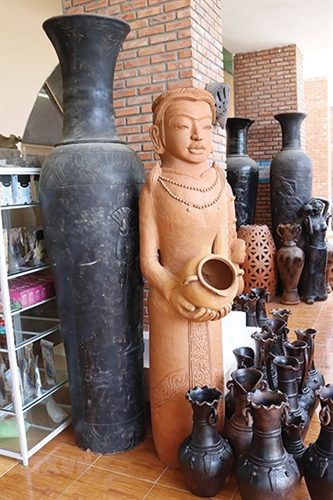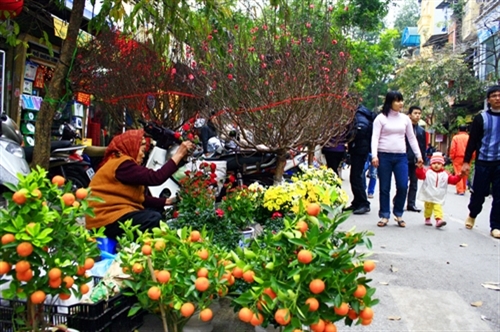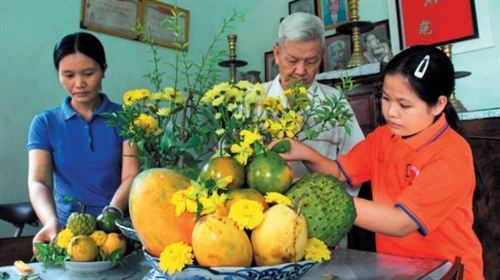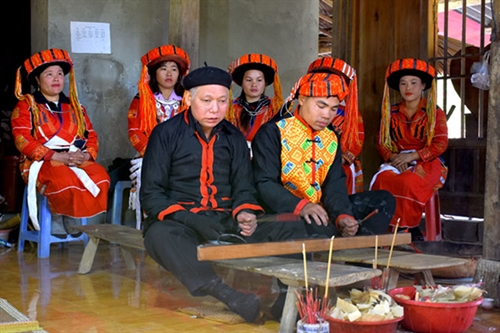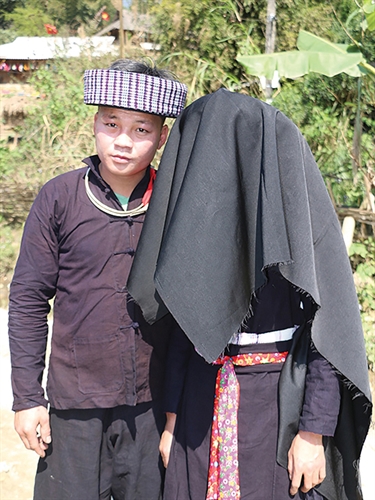Located in Thai Tan commune, Nam Sach district of the Red River delta province of Hai Duong, Chu Dau ceramics village is renowned for their products’ sophisticated patterns, elegant style and glaze diversity.
Traces of Chu Dau ceramics village
According to historians, Chu Dau ceramics craft first appeared at the end of the 14th century, flourished in the 15th and 16th centuries and perished a century later. Historians believe that the civil war between the Mac and Le dynasties was the main reason for the extinction of Chu Dau ceramics village. The destruction of the village forced its local craftsmen to flee to other regions across the country.
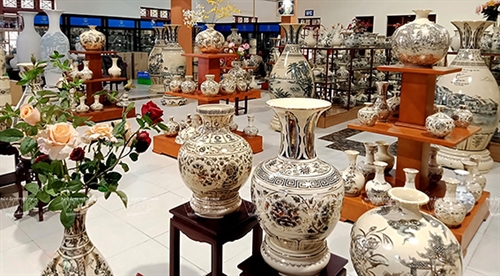 |
| A Chu Dau ceramic showroom__Photo: Trinh Bo (https://vietnam.vnanet.vn/vietnamese) |
However, the ancient Chu Dau ceramics village was traced back since Makoto Anabuki, former Secretary of the Japanese Embassy in Hanoi, sent a letter to Ngo Duy Dong, Secretary of the Party Committee of Hai Hung province (now Hai Duong and Hung Yen provinces) in 1980. In his letter, Anabuki informed the latter of a blue ceramic vase that was on display at Topkapi Sarayi Museum in Istanbul, Turkey, with Chinese characters saying the vase was made by Bui Thi Hy who was living in Nam Sach district at the eighth year of the Thai Hoa dynasty (1450). The Japanese diplomat expressed his wish to verify whether the blue ceramic vase had originated from a local ceramics village.
To search for other artifacts of the village, eight excavations have been carried out on an area of 70,000 square meters in Chu Dau village in Thai Tan and Minh Tan communes since April 1986. Archaeologists found more than 100 underground pottery kiln bottoms full of bowls, plates, pots, jars and pottery molds as well as ancient pottery tools used to prevent sticking and ceramic cracks during firing. The artifacts that were buried two meters below homes in the village center dated back to between the 14th and 16th centuries.
In 1993 and 1997, Chu Dau ceramic items are also found on sunken ships offshore the Philippines and Cu Lao Cham islet in central Quang Nam province. More than 340,000 Chu Dau ceramic items were salvaged, proving that Chu Dau ceramics not only prospered in Vietnam but were also shipped to foreign countries at that time.
Chu Dau craftsmen’s traditional technique is a process of four steps: preparing raw materials, shaping clay, decorating, and glazing and firing.
Preparing raw materials
To make ceramic products, Chu Dau potters take adhesive clay from Luc Dau Giang - the junction of Cau, Thuong, Luc Nam, Duong, Kinh Thay and Thai Binh rivers. In this stage, potters had to use four water tanks to remove impurities from raw clays. At the beginning of earth treatment, raw clay is steeped in water until it becomes decomposed and dissolves in water. The slurry is then drained to the second tank, called sedimentation ark. In this tank, clay particles gradually deposit above gravels and stones while organic substances and other impurities float on the surface and are later removed together with gravels and stones. Then, the deposited material is poured into the third tank, called filter ark, to take out the softest material. Finally, it is taken to the last tank, called fermenting ark, where iron oxide and other impurities are eliminated during three-month fermentation.
Apart from clay, glaze is another important material needed for making traditional Chu Dau ceramics. They are often covered with white, celadon or tam thai glaze (the combination of green, dark red and yellow). However, crackle glaze is the most popular one which is produced from glutinous rice husk ash. Once crackle glaze is applied, ceramic products will have small lines and cracks running under their glaze after they are fired at a high temperature.
Shaping clay
Chu Dau potters make pottery animals and statutes and production tools that are used to prevent pottery sticking and cracks during firing by hand while they use pottery molds to make bowls, plates and cups in bulk. Traditional ceramic items are also made by using a foot-driven wheel. A lump of thoroughly wedged clay is rolled into a coil and placed centrally on the wheel. As the wheel turns, the potter uses only his hands to squeeze and shape the clay piece if it is a small product or to separate the clay piece into smaller ones and reassemble them later to make a big item. Several Chu Dau items are made by the combination of the above three methods. After that, they are placed to dry in cool places until they are leather hard.
Decorating
Before Chu Dau items are glazed, the potters apply soil to some areas on their products and then prune to create shapes, called embossing; or impress patterns on pottery items’ body. In addition, they use brushes to draw motifs and decorative patterns on products. These motifs and decorative patterns are imbued with Vietnamese culture and depict traditional values, philosophy, beliefs and spirit of the Vietnamese people from the ancient periods. These patterns depict the natural scenery and life of the Red River delta inhabitants such as birds sitting on flowers, carp images, fish in water, cottage roofs by rivers, and buffaloes.
Glazing and firing
Decorated products are glazed before being fired. Potters glaze their ceramic items by pouring glaze for the inside, dipping glaze for the coating or sometimes they combine these two methods.
Finally, glazed products are piled up in wood-fueled kilns to be burnt for 12 hours at 1,300 degrees Celsius before finished ceramic products are taken out.
Nowadays, Chu Dau artisans choose the best products from gas-fired ovens to draw gold lines. Gold-lined ceramic products are then fired for the second time for 10 hours at 1,000 degrees Celsius.
Efforts to revive ancient Chu Dau ceramics village
In order to restore the ancient ceramic genre and turn the age-old village into a tourist destination, the South Hanoi Production, Import and Export Service Company (now the Hanoi Trade Joint Stock Corporation - Hapro - a member of the BRG Group) founded Chu Dau Pottery Enterprise on the 33,250-square-meter foundation of the ancient ceramics village in October 2001.
Artists across the country have been invited to study the characteristics of Chu Dau ceramics, and then instruct local potters. Most of young workers back then have now become skilled potters or honored artisans.
The enterprise (now Chu Dau Ceramic Joint Stock Company) has focused on reproducing ancient, valuable and unique ceramic samples as well as developed new product lines with the aim of creating high-quality products with typical artistic value.
In addition, the company has stepped up trade promotion and expanded markets both inside the country and overseas. Since the first batch of products shipped to Spain in May 2003, Chu Dau ceramics have been exported to 32 countries and territories worldwide.
At present, Chu Dau ceramics are on display at 46 museums worldwide. They are also used as gifts, household items and decorations; or gifts as a Vietnamese cultural symbol used by the Government, organizations and enterprises during important diplomatic events.
In September 2019, Chu Dau Ceramic Joint Stock Company was honored to receive the Guinness World Record for its ceramic plate featuring 1,000 words “Long” (dragon) in calligraphy - a masterpiece of Vietnamese handicrafts. Earlier in 2013, the plate was awarded a certificate from the Vietnam Record Association for the largest plate with “Long” written 1,000 times in calligraphy.
The plate not only honors the talent of Chu Dau Ceramic artisans but also glorifies the Vietnamese ceramic industry, which was worthy of the 10 golden words that former Prime Minister Nguyen Xuan Phuc bestowed on the company - “Chu Dau Ceramic - Vietnamese national character, shining over five continents”.- (VLLF)
